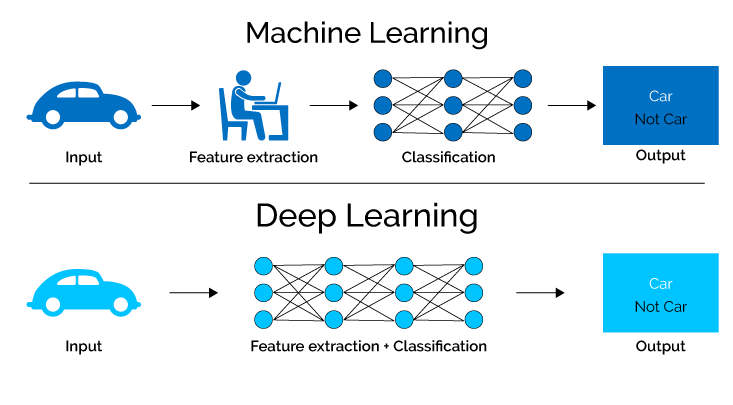What is Deep Learning
Deep learning, a subset of machine learning, involves the development of multi-layered neural networks to model complex patterns and structures in data. By emulating the human brain's structure and function, deep learning algorithms can automatically learn features from data, eliminating the need for manual feature extraction.
Modeling a Single Neuron
A neuron can be depicted as follows:

Artificial Neural Networks And its Intuition
In the neuron model, the concepts of "weights," "bias," and "activation function" are crucial components:
-
Weights
Representing the efficiency of synaptic transmission, weights determine how strongly each neuron influences others. -
Bias
The neuron's sensitivity, bias adjusts the neuron's excitability. -
Activation function
A function describing a neuron's rule for processing information.
The output of a neuron is determined by the following equation:
y f \sum\limits_{k=1}^{n}{x_k}{w_k} x_k w_k \sum k=1 k=n b
In essence, this formula describes the process by which a neuron in an artificial neural network processes the input data. The neuron takes the weighted sum of its inputs, adds the bias term, and then applies the activation function to produce the final output (
Neural Networks
Neural networks are a collection of interconnected neurons, typically arranged in layers. Each neuron in one layer connects to another neuron in the subsequent layer.
Neural networks consist of an input layer, one or more hidden layers, and an output layer:
-
Input layer
Neurons in the input layer initially receive information. -
Hidden layers
These layers process complex data received by the input layer, transforming it into simpler data that can be handled by the output layer. The number of hidden layers can vary depending on the complexity of the information being handled. However, increasing the number of neurons and hidden layers can also increase the required data, memory, and operations. -
Output layer
The output layer produces values processed by the activation function and weighted by the input and hidden layers.
In a neural network, each node (neuron) connects to other nodes, with associated weights and thresholds. When a node's output exceeds a specific threshold, the node is activated, and data is sent to the next layer of the network. Otherwise, no data is forwarded.
Applications of Deep Learning
Deep learning, with its ability to model complex patterns, has a vast array of applications across various domains. These applications extend far beyond the realms of image processing, speech recognition, and natural language processing, touching upon a multitude of other industries and sectors. Some examples of deep learning applications include:
Image Processing
- Image classification
Categorizing images into different classes or labels. - Object detection
Identifying and locating objects within images. - Key point extraction
Extracting features such as human skeleton detection and posture estimation. - Image segmentation
Dividing an image into multiple segments or regions. - Image synthesis
Generating new images by combining or altering existing images. - Style transfer
Applying the artistic style of one image to another.
Speech Recognition
- Text transcription
Converting spoken language into written text - Speaker identification
Recognizing the identity of a speaker based on their voice characteristics. - Voice command recognition
Interpreting and executing spoken commands. - Language identification
Detecting the language being spoken in an audio clip.
Natural Language Processing
- Emotion analysis
Identifying and categorizing emotions expressed in text. - Sentence summarization
Generating a concise summary of a given text. - Machine translation
Translating text from one language to another. - Sentiment analysis
Determining the sentiment or tone of a piece of text (e.g., positive, negative, or neutral). - Named entity recognition
Identifying and classifying entities such as people, organizations, and locations within a text. - Chatbots and conversational AI
Creating AI systems capable of engaging in human-like conversations.
Healthcare
- Medical image analysis
Analyzing medical images for diagnostic purposes or to monitor disease progression. - Drug discovery
Identifying potential drug candidates by analyzing chemical structures and properties. - Personalized medicine
Developing customized treatment plans based on an individual's genetic makeup and other factors.
Finance
- Fraud detection
Identifying suspicious transactions or activities that may indicate fraud. - Algorithmic trading
Automating trading decisions based on market data and predefined strategies. - Credit scoring
Assessing the creditworthiness of individuals or businesses.
Autonomous Vehicles
- Environmental perception
Enabling vehicles to perceive and understand their surroundings through sensor data. - Path planning
Determining the optimal route for a vehicle to navigate from one point to another. - Control and decision-making
Facilitating real-time decision-making for vehicle control and maneuvering.
References

